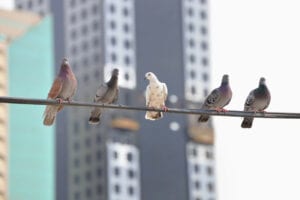
by Pigeon Patrol | Aug 9, 2021 | Pigeon Patrol's Services, Pigeon Predators, Pigeon Spikes, Pigeons, Pigeons in the News, Raccoons
It may sound hard to believe, but pigeons are actually a bit of a nuisance to human populations, no matter how attractive these pests can be. Pest control measures frequently include pigeon deterrent procedures due to the risk of disease and property damage that pigeons can bring.
When getting rid of pigeons, practical traps and repellents are the best options to utilise to ensure the birds are repelled from your property. Falconry, anti-bird spikes, parallel wires, bird netting, bird gels, decoy kites, and lasers are all effective in ridding pigeons from your property.
This article will go over some basic tips about pigeon behaviour as well as a range of ways to help keep pigeons away. Read on to discover more. If you are interested in our pigeon control services then please contact us for a quote.
Pigeon Behaviour
Pigeons have long been a bird that is renowned for its beauty but feared for its nuisance behaviour. The types of pigeons that regularly cause concern for home and business owners are known as feral pigeons.
Pigeons will typically gather together in a behaviour known as roosting, which is easily seen by detecting large groups of pigeons congregating on rooftops and the eaves and sides of buildings. Even if you go to great lengths to never feed pigeons to help get rid of them, most people usually feed pigeons inadvertently by dropping grain-rich foods on the ground and leaving the lids of waste bins.
Similar in the way that cockroaches and bed bugs are dependent on humans for food and shelter, it can be said that pigeons share the same trait. These pests have come to rely on grains for survival, which is why pigeons are a staple of the surrounding environment of agricultural sites, feed processing plants, as well as parks, large recreation areas, and restaurants located within cities.
This may not sound alarming, but pigeons regularly drop waste on sidewalks and buildings, which can damage the exterior look of structures over time. Additionally, people can slip and fall when walking through pigeon waste, and feral pigeons can actually carry a range of diseases.
With this in mind, considering how to get rid of pigeons is a valid question to ask.
How to Get Rid of Pigeons Without Hurting Them
It is illegal to kill pigeons or any other wild bird species due to the wording of the Wildlife and Countryside Act of 1981. This means that the birds can only be repelled, and by far, the best way to scare pigeons and keep nesting pigeons away is to use falconry.

Falconry
There are some products that you can use to deter pigeons (more on these below), but the use of birds of prey is great because this natural method directly triggers the fight or flight response within pigeons.
Our method is to allow our birds to circle and fly over the problem area on a regular basis. Pigeons soon get the message that the territory is occupied by a predator, and will take wing and move on.
Using a natural threat like this is the most humane and effective way to rid your property of pigeons on a long-term basis. Falconry can deter pigeons and prevent pigeons from becoming a nuisance to your property, and you do not have to worry about utilising spike strips or other pigeon deterrents to get rid of pigeons.
Additional Procedures to Take to Keep Pigeons Away
When it comes to figuring out how to get rid of pigeons, falconry is the most natural and effective form of pest control you can use. Precautionary measures like removing bird feeders or leaving food and water out of bird feeders can be effective, but it will likely take more than refraining from the urge to feed pigeons to break up the habit of roosting.
In all of the following procedures, you have to make sure that whatever form of pest control you take, the pigeons may become accustomed to the devices, and therefore, you may have to change up the procedure from time to time to get rid of pigeons and keep them away.
Let’s explore some methods to get rid of pigeons:
Anti-Bird Spikes
Anti-bird spikes or ‘spike strips’ are a set of attachable spikes that can be fastened to a surface to prevent pigeons from perching or nesting in areas you want to keep bird-free. The spikes will not necessarily harm the birds, which is good in order to stay on the right side of the law; however, the spikes will deter the birds from setting up shop wherever the spikes are laid.
Parallel Wires
Bird-proofing with parallel wires is a great way to keep pigeons away from your roof or other areas of your home that are attractive to the birds. This method works by using parallel wires that run across the structure that prevents pigeons from landing and nesting.
Bird Netting
Bird netting is somewhat unsightly but is very effective at keeping pigeons out of certain places. This mesh netting works much like the previous examples and creates a net barrier that prevents the birds from nesting.
Bird Gels
A sticky trap, or sticky gel, is a bird repellent that keeps pigeons at bay by using a chemical that creates a translucent barrier across structures that causes a bird’s feet to become stuck to the surface, which makes the bird struggle to get free. A pigeon would not want to go through the experience of having to break free of the sticky chemical a second time and therefore, will avoid landing on structures that contain the gel.
Decoy Kites
Decoy kites can get rid of bird populations by using a kite-shaped decoy bird image to sway in the wind to deter a pigeon from landing in a certain area. This method can be effective, but it may not work since decoys can sometimes be easily overlooked, which makes this method problematic to get rid of pigeons.
Lasers
Lasers used against pigeon populations can be effective due to the piercing light that blinds the pigeons once they scout an area for nesting or roosting. This method can be initially effective, however, the pigeons may become accustomed to the lasers over time and simply get out the way.
What Do Pigeons Hate?
Pigeons hate the sight or presence of other domineering birds, such as birds of prey. This is what makes falconry such a successful deterrent in getting rid of pigeon populations.
Additionally, pigeons do not like strong smells, such as cinnamon or hot pepper juice or spray. If you can safely reach the areas where the pigeon colony is roosting and nesting, you can spray and apply these substances to help drive the birds away.
How Do I Get Rid of Pigeons On My Roof?
Pigeon colonies look for places to hide and nest and there is no better area better suited for this than the roof. When it comes to figuring out how to scare off pigeons from your roof, the best method is to figure out methods that will keep populations away from the roof.
A good pigeon repellent to consider using for your roof is bird netting or parallel wires. These two methods need little upkeep on your part and can work around the clock to keep the birds firmly off of your roof.
If you are wondering how to scare pigeon colonies from roof structures, decoy kites require less installation, but you have to make sure the birds do not become used to the sight of the decoy kite.
Falconry is the easiest method to consider since our birds mimic the same basic patterns of flight and acclimating to heights as pigeons.
What Smell Do Pigeons Not Like?
As previously mentioned, strong and repellent scents and smells like pepper or even essential oils may deter pigeon populations for a time. To get rid of pigeons completely with smells, you would have to consistently spread the scents all over their roosting and nesting spots to make the habitat unlivable.
Source
Pigeon Patrol Products & Services is the leading manufacturer and distributor of bird deterrent (control) products in Canada. Pigeon Patrol products have solved pest bird problems in industrial, commercial, and residential settings since 2000, by using safe and humane bird deterrents with only bird and animal friendly solutions. At Pigeon Patrol, we manufacture and offer a variety of bird deterrents, ranging from Ultra-flex Bird Spikes with UV protection, Bird Netting, 4-S Bird Gel and the best Ultrasonic and audible sound devices on the market today.
Voted Best Canadian wholesaler for Bird Deterrent products ten years in a row.
Contact us at 1- 877– 4– NO-BIRD, (604) 585-9279 or visit our website at www.pigeonpatrol.ca
Pigeon/Pigeon Patrol / Pigeons Roosting / Vancouver Pigeon Control /Bird Spikes / Bird Control / Bird Deterrent / Pigeon Deterrent? Surrey Pigeon Control / Pest /Seagull deterrent / Vancouver Pigeon Blog / Birds Inside Home / Pigeons in the cities / Ice Pigeons/ What to do about pigeons/ sparrows , Damage by Sparrows, How To Keep Raccoons Away, Why Are Raccoons Considered Pests/ De-fence / Pigeon Nesting/ Bird Droppings / Pigeon Dropping/ woodpecker control/ Professional Bird Control Company/ Keep The Birds Away/ Birds/rats/ seagull/pigeon/woodpecker/ dove/sparrow/pidgeon control/pidgeon problem/ pidgeon control/flying rats/ pigeon Problems/ bird netting/bird gel/bird spray/bird nails/ bird guard

by Pigeon Patrol | Aug 9, 2021 | Pigeon Spikes, Pigeons, Pigeons in the News, Raccoons, Sparrows, UltraSonic Bird Control
Scientists have discovered the secret of pigeons’ remarkable ability to navigate perfectly over journeys of several hundred miles. They do it by smell.
Research found that pigeons create ‘odour’ maps of their neighbourhoods and use these to orient themselves. This replaces the idea that they exploited subtle variations in the Earth’s magnetic field to navigate.
‘This is important because it is the first time that magnetic sensing and smell have been tested side by side,’ said Anna Gagliardo, of the University of Pisa, who led the research.
The discovery that birds have an olfactory positioning system is the latest surprising discovery about bird migration. Birds know exactly when to binge on berries or insects to fatten themselves for long flights, and some species recognise constellations, which helps them to fly at night. Birds also travel immense distances: the average Manx shearwater travels five million miles during its life.
Research into navigation has included an experiment in which robins were released with a patch over one eye – some on the right eye, some on the left. The left-eye-patched robins navigated well, but those with right-eye patches got hopelessly lost. ‘It is a very strange finding,’ said Graham Appleton, of the British Trust for Ornithology . ‘It is clear the cues robins use to navigate are only detectable in one eye. Why that should be the case, I have no idea.’
In the Pisa experiments, Gagliardo, working with Martin Wild of the University of Auckland , followed up experiments done in 2004, which showed that pigeons could detect magnetic fields. She argued that this did not mean they actually did.
So in 24 young homing pigeons she cut the nerves that carried olfactory signals to their brains. In another 24 pigeons she cut the trigeminal nerve, which is linked to the part of the brain involved in detecting magnetic fields.
The 48 birds were released 30 miles from their loft. All but one of those deprived of their ability to detect magnetic fields were home within 24 hours, indicating that it was not an ability that helped them to navigate. But those who had been deprived of their sense of smell fluttered all over the skies of northern Italy. Only four made it home.
Gagliardo and her team conclude that pigeons read the landscape as a patchwork of odours.
Every spring, hundreds of millions of birds head north in order to exploit new resources. Gulls head to the Arctic to make use of the 24 hours of daylight prevailing there, while swallows and other birds leave Africa to exploit the British summertime.
The navigation involved in these long journeys is still a cause of considerable debate among scientists. Among the main theories are suggestions that some birds remember visual maps of the terrain they fly over; that they follow the lines of Earth’s magnetic field; and that night-time flyers remember star maps of the sky.
However, the discovery of pigeons’ prowess at exploiting smells is considered important because their navigational abilities are some of the most acute in the natural world. Pigeons excel at getting home when released in unfamiliar locations. That they achieve such accuracy using smell is all the more surprising.
Source
Pigeon Patrol Products & Services is the leading manufacturer and distributor of bird deterrent (control) products in Canada. Pigeon Patrol products have solved pest bird problems in industrial, commercial, and residential settings since 2000, by using safe and humane bird deterrents with only bird and animal friendly solutions. At Pigeon Patrol, we manufacture and offer a variety of bird deterrents, ranging from Ultra-flex Bird Spikes with UV protection, Bird Netting, 4-S Bird Gel and the best Ultrasonic and audible sound devices on the market today.
Voted Best Canadian wholesaler for Bird Deterrent products ten years in a row.
Contact us at 1- 877– 4– NO-BIRD, (604) 585-9279 or visit our website at www.pigeonpatrol.ca
Pigeon/Pigeon Patrol / Pigeons Roosting / Vancouver Pigeon Control /Bird Spikes / Bird Control / Bird Deterrent / Pigeon Deterrent? Surrey Pigeon Control / Pest /Seagull deterrent / Vancouver Pigeon Blog / Birds Inside Home / Pigeons in the cities / Ice Pigeons/ What to do about pigeons/ sparrows , Damage by Sparrows, How To Keep Raccoons Away, Why Are Raccoons Considered Pests/ De-fence / Pigeon Nesting/ Bird Droppings / Pigeon Dropping/ woodpecker control/ Professional Bird Control Company/ Keep The Birds Away/ Birds/rats/ seagull/pigeon/woodpecker/ dove/sparrow/pidgeon control/pidgeon problem/ pidgeon control/flying rats/ pigeon Problems/ bird netting/bird gel/bird spray/bird nails/ bird guard

by Pigeon Patrol | Aug 3, 2021 | Bird Spike, Pigeon Predators, Pigeon Spikes, Pigeons, Pigeons in the News, Raccoons, Sparrows, UltraSonic Bird Control
“Safe pigeon-feeding zones” may be designated around the city as part of the negotiations between animal rights groups and the Brooklyn city councilman who has proposed fining pigeon feeders as much as $1,000 as strategy to control New York’s pigeon population.
Fines, which had been used successfully in Basel, Switzerland, to limit pigeon proliferation, were the most concrete proposal in a pigeon report issued by Councilman Simcha Felder’s office in November. Other ideas in the report included pigeon birth control and a pigeon czar.
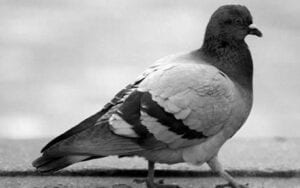
But the report and the proposed fines brought out a number of pigeon proponents who defended the urban birds’ rights to co-exist with humans in New York’s sprawl. Since November, Mr. Felder’s office has been meeting with a number of groups over the fine-for-feeding legislation. In December, at one of those meetings, the Humane Society brought up the idea of safe pigeon-feeding zones with Mr. Felder’s office.
“If our idea was, there are too many pigeons around where people are walking, waiting for the subway, sitting in parks, etc.,” said Eric Kuo, a spokesman for Mr. Felder. “Someone brought up, if there are areas where people are not around, what’s the harm of allowing feeding there?”
The pigeon-friendly zones could include less-densely trafficked areas in Central Park and Prospect Park, Mr. Kuo said. The City Council’s lawyers who draft legislation have been asked to see if such a plan is feasible.
Source
Pigeon Patrol Products & Services is the leading manufacturer and distributor of bird deterrent (control) products in Canada. Pigeon Patrol products have solved pest bird problems in industrial, commercial, and residential settings since 2000, by using safe and humane bird deterrents with only bird and animal friendly solutions. At Pigeon Patrol, we manufacture and offer a variety of bird deterrents, ranging from Ultra-flex Bird Spikes with UV protection, Bird Netting, 4-S Bird Gel and the best Ultrasonic and audible sound devices on the market today.
Voted Best Canadian wholesaler for Bird Deterrent products ten years in a row.
Contact us at 1- 877– 4– NO-BIRD, (604) 585-9279 or visit our website at www.pigeonpatrol.ca
Pigeon/Pigeon Patrol / Pigeons Roosting / Vancouver Pigeon Control /Bird Spikes / Bird Control / Bird Deterrent / Pigeon Deterrent? Surrey Pigeon Control / Pest /Seagull deterrent / Vancouver Pigeon Blog / Birds Inside Home / Pigeons in the cities / Ice Pigeons/ What to do about pigeons/ sparrows , Damage by Sparrows, How To Keep Raccoons Away, Why Are Raccoons Considered Pests/ De-fence / Pigeon Nesting/ Bird Droppings / Pigeon Dropping/ woodpecker control/ Professional Bird Control Company/ Keep The Birds Away/ Birds/rats/ seagull/pigeon/woodpecker/ dove/sparrow/pidgeon control/pidgeon problem/ pidgeon control/flying rats/ pigeon Problems/ bird netting/bird gel/bird spray/bird nails/ bird guard
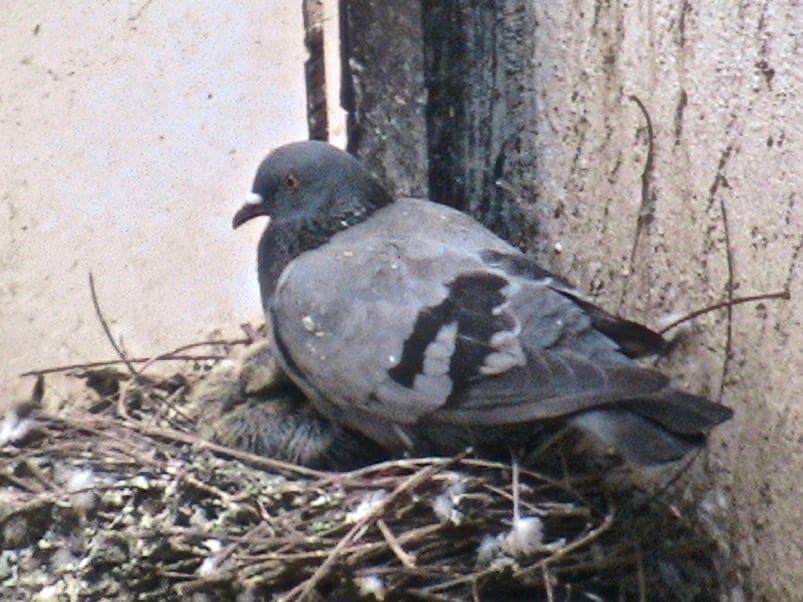
by Pigeon Patrol | Aug 3, 2021 | Bird Spike, Pigeon Patrol's Services, Pigeon Predators, Pigeon Spikes, Pigeons, Pigeons in the News
How do animals become problems? Drawing on interactionist theories of social problems and cultural geography, I argue that the construction of animals as problems relies upon cultural understandings of nature/ culture relationships, which in turn entail “imaginative geographies.” Specifically, modernity posits a firm boundary between nature and culture. Animals have their place, but are experienced as “out of place”-and often problematic-when they are perceived to transgress spaces designated for human habitation. Relying on New York Times articles from 1851 to 2006, and articles from 51 other newspapers from 1980 to 2006, this article focuses on the process by which pigeons as a species were problematized. I contend that pigeons have come to represent the antithesis of the ideal metropolis, which is orderly and sanitized, with nature subdued and compartmentalized. While typified as a health issue, the pigeon’s primary “offense” is that it “pollutes” habitats dedicated for human use. The catch phrase “rats with wings” neatly summarizes society’s evaluations of, and anxieties about, this bird. This metaphor reflects a framing of pigeons by claims-makers that renders them out of place in the cityscape. This study expands social problems theorizing to more thoroughly account for animals and the role of space.
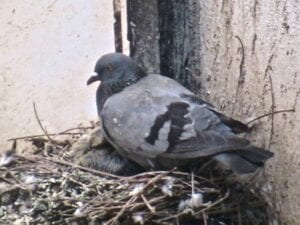
Source
Pigeon Patrol Products & Services is the leading manufacturer and distributor of bird deterrent (control) products in Canada. Pigeon Patrol products have solved pest bird problems in industrial, commercial, and residential settings since 2000, by using safe and humane bird deterrents with only bird and animal friendly solutions. At Pigeon Patrol, we manufacture and offer a variety of bird deterrents, ranging from Ultra-flex Bird Spikes with UV protection, Bird Netting, 4-S Bird Gel and the best Ultrasonic and audible sound devices on the market today.
Voted Best Canadian wholesaler for Bird Deterrent products ten years in a row.
Contact us at 1- 877– 4– NO-BIRD, (604) 585-9279 or visit our website at www.pigeonpatrol.ca
Pigeon/Pigeon Patrol / Pigeons Roosting / Vancouver Pigeon Control /Bird Spikes / Bird Control / Bird Deterrent / Pigeon Deterrent? Surrey Pigeon Control / Pest /Seagull deterrent / Vancouver Pigeon Blog / Birds Inside Home / Pigeons in the cities / Ice Pigeons/ What to do about pigeons/ sparrows , Damage by Sparrows, How To Keep Raccoons Away, Why Are Raccoons Considered Pests/ De-fence / Pigeon Nesting/ Bird Droppings / Pigeon Dropping/ woodpecker control/ Professional Bird Control Company/ Keep The Birds Away/ Birds/rats/ seagull/pigeon/woodpecker/ dove/sparrow/pidgeon control/pidgeon problem/ pidgeon control/flying rats/ pigeon Problems/ bird netting/bird gel/bird spray/bird nails/ bird guard

by Pigeon Patrol | Jul 27, 2021 | Pigeon Patrol's Services, Pigeon Predators, Pigeon Spikes, Pigeons, Pigeons in the News, Raccoons
While most Canada Geese spend the spring and fall migrating back and forth between their winter and summer habitat, some sub-populations of the Canada Goose have sprung up in many urban and suburban areas, living there year-round. In many cities they have become quite the pest – hanging around popular areas, hissing at children, and leaving their infamous waste seemingly everywhere.
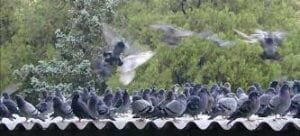
Our Senior Scientist Dr. Jeff Wells spoke with host Marc Montgomery on Radio Canada International’s The Link, a daily show that covers a wide range of news stories. Dr. Wells explains how these, as he likes to call them, “pigeon geese” came to be and how they are different from wild migratory geese. He also weighs in on New York City’s plans to kill hundreds, if not thousands of them, and ways to make good out of unfortunate situations…
Source
Pigeon Patrol Products & Services is the leading manufacturer and distributor of bird deterrent (control) products in Canada. Pigeon Patrol products have solved pest bird problems in industrial, commercial, and residential settings since 2000, by using safe and humane bird deterrents with only bird and animal friendly solutions. At Pigeon Patrol, we manufacture and offer a variety of bird deterrents, ranging from Ultra-flex Bird Spikes with UV protection, Bird Netting, 4-S Bird Gel and the best Ultrasonic and audible sound devices on the market today.
Voted Best Canadian wholesaler for Bird Deterrent products ten years in a row.
Contact us at 1- 877– 4– NO-BIRD, (604) 585-9279 or visit our website at www.pigeonpatrol.ca
Pigeon/Pigeon Patrol / Pigeons Roosting / Vancouver Pigeon Control /Bird Spikes / Bird Control / Bird Deterrent / Pigeon Deterrent? Surrey Pigeon Control / Pest /Seagull deterrent / Vancouver Pigeon Blog / Birds Inside Home / Pigeons in the cities / Ice Pigeons/ What to do about pigeons/ sparrows , Damage by Sparrows, How To Keep Raccoons Away, Why Are Raccoons Considered Pests/ De-fence / Pigeon Nesting/ Bird Droppings / Pigeon Dropping/ woodpecker control/ Professional Bird Control Company/ Keep The Birds Away/ Birds/rats/ seagull/pigeon/woodpecker/ dove/sparrow/pidgeon control/pidgeon problem/ pidgeon control/flying rats/ pigeon Problems/ bird netting/bird gel/bird spray/bird nails/ bird guard
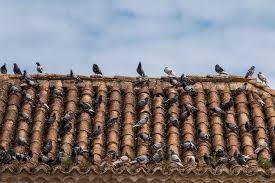
by Pigeon Patrol | Jul 27, 2021 | Pigeon Spikes, Pigeons, Pigeons in the News, Raccoons, Sparrows, UltraSonic Bird Control
The recently changed name of Rock Pigeon reflects its traditional nesting site on rocky cliffs (replaced by buildings for feral populations) and its membership in the genus Columba, most of whose approximately 54 species are known as pigeons (Monroe and Sibley 1993). This species can be seen in a variety of colors, ranging from the white of “homing pigeons” to the mostly gray of the Old World wild population.
DISTRIBUTION. During the 1987-1992 field work seasons of the TBBA project, observers found breeding evidence across the state for Rock Pigeons, although breeding was more widely scattered in the Rolling Plains, Edwards Plateau and Trans-Pecos regions (see the region map in Lockwood and Freeman [2004]).

The 3 most common introduced species found on TBBA maps are in order: House Sparrows (Passer domesticus), widespread in all regions except the Trans-Pecos; European Starlings (Sturnus vulgaris), widespread in Texas except for the Edwards Plateau and Trans-Pecos regions, and the Rock Pigeon. Of the doves and pigeons in Texas, atlasers found Mourning Doves (Zenaida macroura) to be even more widespread than any of the introduced species or other doves or pigeons.
This pigeon is found in the New World from south-central Alaska, along the west coast of Canada and across the southern part of that nation to the Atlantic Coasst. From Canada the range extends south to Tierra del Fuego at the tip of South America. The species is either native or introduced to most of the Old World and many oceanic islands (Johnston 1992, Am. Ornithol. Union 1998, Sauer et al. 2007).
SEASONAL OCCURRENCE. Rock Pigeons are residents in Texas, breeding year round, but less commonly in the coldest months (Oberholser 1974).
BREEDING HABITAT. Rock Pigeons in Texas are found primarily in cities, towns and agricultural areas (Oberholser 1974) similar to Colorado and Arizona where almost 90% of breeding was observed in these areas (Kuenning 1998, Wise-Gervais 2005). The nest, generally built in or on a building, is a carelessly arranged platform of grass, straw, feathers and debris on a solid surface. On this platform the female usually lays 2 smooth, glossy, white, unmarked eggs which are incubated by both parents for 17-19 days. The nestling period varies seasonally from 25-32 days in summer to as long as 45 days in mid-winter. The fledglings usually remain near their parents for 1-2 weeks and may be driven away after that if they do not leave (Harrison 1979, Johnston 1992).
STATUS .Rock Pigeons are common in Texas (Lockwood and Freeman 2004) with relative abundances as high as 10-30 pigeons per North American Breeding Bird Survey (BBS) route in a few parts of the state, although in most areas relative abundances range from <1 to <10. BBS trend data from 95 routes in Texas suggest little population change has occurred since 1980, consistent with the statistically significant survey wide trend of -1.0% annual population change (Sauer et al. 2007).
Source
Pigeon Patrol Products & Services is the leading manufacturer and distributor of bird deterrent (control) products in Canada. Pigeon Patrol products have solved pest bird problems in industrial, commercial, and residential settings since 2000, by using safe and humane bird deterrents with only bird and animal friendly solutions. At Pigeon Patrol, we manufacture and offer a variety of bird deterrents, ranging from Ultra-flex Bird Spikes with UV protection, Bird Netting, 4-S Bird Gel and the best Ultrasonic and audible sound devices on the market today.
Voted Best Canadian wholesaler for Bird Deterrent products ten years in a row.
Contact us at 1- 877– 4– NO-BIRD, (604) 585-9279 or visit our website at www.pigeonpatrol.ca
Pigeon/Pigeon Patrol / Pigeons Roosting / Vancouver Pigeon Control /Bird Spikes / Bird Control / Bird Deterrent / Pigeon Deterrent? Surrey Pigeon Control / Pest /Seagull deterrent / Vancouver Pigeon Blog / Birds Inside Home / Pigeons in the cities / Ice Pigeons/ What to do about pigeons/ sparrows , Damage by Sparrows, How To Keep Raccoons Away, Why Are Raccoons Considered Pests/ De-fence / Pigeon Nesting/ Bird Droppings / Pigeon Dropping/ woodpecker control/ Professional Bird Control Company/ Keep The Birds Away/ Birds/rats/ seagull/pigeon/woodpecker/ dove/sparrow/pidgeon control/pidgeon problem/ pidgeon control/flying rats/ pigeon Problems/ bird netting/bird gel/bird spray/bird nails/ bird guard




